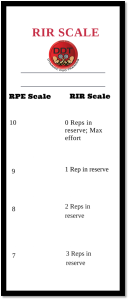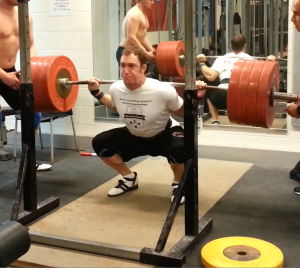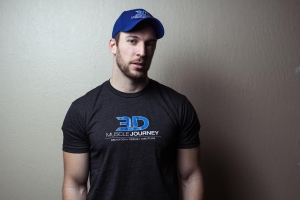Train Loco Nation! Today we have an awesome and very informative interview with Eric Helms of 3DMJ. Eric is doing his graduate research in Strength and Conditioning with a focus on Autoregulation Training. There are a lot of misconceptions within Autoregulation Training and we figured Eric would be a great person to straighten some of those misconceptions out. Since he’s doing research within Autoregulation, has used this method himself, as well as with clients, he’s an expert in strength and conditioning, and let’s not forget to add…Helms is just a straight up BAD ASS! Without further ado, let’s get this rockin and rollin!
– Chris and Eric
DDT: Could you give us a little background info on who Eric Helms is?
Helms: Certainly, but first let me say thank you guys for the interview, it’s an honor! I am a guy who loves lifting first and foremost. Back in 2005 I decided I wanted to make a career out of that, so I started personal training and eventually fell in love with bodybuilding and powerlifting (recently dabbling in Olympic lifting). Fast forward to present day, I’ve become heavily involved with natural bodybuilding, raw powerlifting, coaching bodybuilders and powerlifters and I’ve pursued an academic career in exercise science and nutrition. I formed 3D Muscle Journey with fellow Natural Pros Jeff Alberts, Brad Loomis and Alberto Nunez in 2009 with the goal of elevating and supporting the drug free strength and physique community and providing evidence based information and coaching. I’ve also pushed my boundaries academically. To date I’ve completed a couple masters’ degrees, published multiple peer reviewed papers on relevant topics and I’m about half way through my PhD at the Auckland University of Technology, in New Zealand, studying auto regulation in resistance training.
DDT: What is Autoregulation training?
Helms: Autoregulation is any approach that automatically adjusts based on the feedback of the trainee. This can take many forms, such as modifying your training based on certain physiological data like heart rate variance, or subjective questionnaires on stress levels, or any other metric that is representative of readiness and/or recovery. But, I think the most intriguing area are approaches that embed autoregulation into a training approach automatically. A well-known example would be using a rating of perceived exertion (RPE) value of 1 to 10 to assign load versus say percentage of 1RM.
DDT: What got you started or inspired to get into doing research, specifically research on Autoregulation?
Helms: I was very intrigued by the work of Mike Tuchscherer of Reactive Training Systems, and how he was using RPE scores to assign load and a method called fatigue percentages to regulate the number of sets performed. Once I got into my graduate research, I knew this was one area I wanted to put under the proverbial microscope.
DDT: With periodization, we have Linear Periodization (LP), Non-Linear Periodization (NLP), Daily Undulating Periodization (DUP), and Block Periodization (BP). The research is pretty clear that all of these forms of periodization are more optimal than no periodization at all; can you explain where the concept of Autoregulation fits in here?
Helms: To be honest, there are almost no forms of training out there that aren’t periodized at least to some degree. Periodization in a strict sense according to the literature just means it attempts progression and has some form of variation. So while it is true that periodization is better than no periodization, it’s also important to understand that almost every form of training you can think of is probably periodized in strict terms.
Now, autoregulation in the form that I am researching is not a form of periodization. I think that’s a big misconception. You can use RPE to assign load within the context of any periodization model, and you can use a fatigue percentage to assign volume within the context of any periodization model if you understand how a fatigue percentage operates as well. Really, using either RPE or a fatigue percentage is just a way to allow for fluctuations in day to day work capacity or strength, within a periodization plan, rather than something separate or distinct.
DDT: What is the big difference between having an RPE scale to gage your repetitions vs using an RIR (repetitions in reserve) system?
Helms: Traditional RPE scales were developed decades ago and were based on descriptors of effort. For example, “extremely difficult” or “maximal exertion” might be a descriptor in a classical RPE scale. However, the classical RPE scales were developed for aerobic training not resistance training. So, they don’t often translate perfectly to resistance training. For example, a fair number of studies using classical RPE scales on resistance training have found that people don’t rate going to failure as a 10 out of 10 RPE. I would imagine this is probably because while doing a set of 5 to failure or a 1 rep max is hard, it doesn’t compare to something like running a marathon, or doing burpees until you puke, or doing wind sprints etc etc etc. So the reference point of comparing a set to failure against other experiences isn’t always represented by “maximal effort”.
Thus, Mike Tuchscherer based his scale on something more objective, how many repetitions in reserve you had after each set. Meaning, a 10 out of 10 RPE means you could do 0 reps more. So basically with this system, RPE is inverse to RIR. 10 RPE means 0 RIR, 9 RPE means 1 RIR etc etc etc.
And in recent research published by Dr. Zourdos that I assisted with and in a study by Hackett and colleagues in 2012, it’s been shown that using RIR might be a more accurate way to gauge intensity on a set of resistance training than classical RPE.
DDT: What were the major findings in your recent study with Dr. Zourdos compared to the 2012 paper by Hackett and colleagues? How can your findings be applied to practical training setting?
Helms: Hackett took bodybuilders and had them perform multiple sets of 70% of 1RM on both squats and bench presses. Mid set they would have them stop at the top of the repetition, and state verbally how many more reps they thought they could perform. Some sets they would then take to failure. At the completion of a set they reported a classical RPE value of 1-10. So, they were able to compare actual RIR, to predicted RIR and also see how classical RPE stacked up in comparison. They found that not only were the lifters very good at estimating RIR, only being off by at most 1 rep compared to actual RIR, but that also classical RPE was less accurate than RIR predictions, and often even going to failure RPE’s of less than 10 were reported by the participants.
Hackett built a strong case for the use of an RPE scale based on RIR, and that’s exactly what we tested in the study lead by Dr. Zourdos. We used a scale similar to Mike Tuchscherer’s in which RPE was based on RIR. We had two groups, novice squatters and experienced squatters. Both worked up to a 1RM, determined by either a set rated at a 10 RPE, or, if they made an increase in load and missed the attempt, then the last load and RPE were recorded. For example, let’s say I did a 200kg squat, rated it as a 9 RPE, then jumped to 205kg and missed the squat. I’d be stuck with a 200kg max and a 9 RPE rating. This was how the accuracy of using the scale was determined. We found that experienced lifters were not only more accurate at rating RPE, but also more capable of reaching a true 1RM. To break down what I mean, not only were experienced lifters more likely to rate 1RMs as 10 RPEs, but the experienced lifters were able to complete attempts at a slower velocity on the concentric portion. Meaning, they were able to hold form and continue exerting force through the sticking region and complete heavier attempts, while the novices could not. Thus, not only are novice lifters poorer at rating RIR, but novice lifters are also simply not capable of maintaining the same level of control needed to complete very heavy loads relative to what they should be able to accomplish, thus they might overestimate their 1RM strength.
The practical take home from these studies is that experienced lifters, when taking sets relatively near to failure (say a 7-10 RPE) are quite accurate when using an RIR based RPE scale.
DDT: In a fantastic paper by John Kiely titled “Periodization Paradigms in the 21st century: Evidence led or tradition driven.” He stated the following:
“In addition, consider the influence exerted by environmental and Lifestyle factors on biological responses. For example, a wide range of imposed stressors such as: emotional, dietary, social, sleep, academic, etc. These all have been demonstrated to variously down regulate the immune system, dampen adaptive response, and negatively affect motor coordination, cognitive performance, mood, metabolism, and hormonal health (Rogers 2001; Aubert 2008; Stranahan 2006; Savtchouk 2011; Carl 2001), and these all consequently reduce performance (Paulus 2009) and elevate risk injury (Kelman 2000).”
This is where we find the flexibility of Autoregulation intriguing. Do you see Autoregulation as a superior form of programming because of some of the stressors Kiely spoke about?
Helms: Potentially, as autoregulation really focuses on the individualization aspects of what Kiely wrote about. His paper was an attempt to break people out of the traditional mindset of looking at periodization models as rigid, distinct, separate models that must be followed to a T that control for all possible variables. The reality is that so many stresses that effect athletes and their ability to adapt to training are simply not controllable, so some inherent amount of flexibility and individualization must exist for any training approach to be “optimal”.
The reality is that so many stresses that effect athletes and their ability to adapt to training are simply not controllable, so some inherent amount of flexibility and individualization must exist for any training approach to be “optimal”.
DDT: What are the major pros and cons to Autoregulation?
Helms: The potential pros are pretty obvious, you’re attempting to match the volume and intensity of the day (within the context of the goal of the day within the periodization strategy) to the readiness and recovery of the individual. Theoretically, this would allow the person to “strike” when the iron is hot and potentially perform in the sweet spot of their capacities on a day to day basis. It’s essentially making sure that the intended stress of the program, matches the stress experienced by the person. Without doing this, sometimes a workout intended to be easy can be hard if the person is under recovered, and a workout intended to be hard can be easy if the person is in a high state of readiness.
The cons, like most things, come down to user error. Those who think autoregulation is magic, or a distinct program, versus a tool to be incorporated into a program, may find themselves floundering if they lose elements of structure because they don’t know how to incorporate autoregulation into a plan. Also, inexperienced lifters jumping in and using these methods might be less accurate in their loading than if they’d used something more traditional like a rep max or percentage 1RM to guide loads. The same could be true for experienced lifters as well if they don’t spend a few weeks familiarizing themselves to the scale before implementing it.
DDT: The only real big issue we can see with Autoregulation would come down to the trainee’s experience level and not being able to really gage their RPE and repetitions in reserve accurately. Meaning they would either train to failure too often or they wouldn’t train hard enough. Do you see this as a problem?
Helms: Yup, that’s correct this can be problem, and it’s potentially not just an issue with accuracy. Some people have trouble being honest with themselves, and may push too heavy with the scale, being overzealous and often overshooting the target RPEs. So experience, familiarization and self-honesty are critical. Not everyone is going to be suited for this type of training.
DDT: Would Autoregulation be best suited for novice, intermediate, or advanced athletes?
Helms: Intermediates and advanced athletes would be the most appropriate populations to use the scale. If you can’t tell when you could have done 1 more rep versus 2 more reps, you simply haven’t been lifting long enough to use the scale.
DDT: What are the main misconceptions you see on programming and Autoregulation?
Helms: The big one is that autoregulation is a distinct, system, program or type of training. It’s not, it’s a method of assigning and adjusting load and volume, that can be integrated into a periodization model or training plan.
DDT: How does one know they are ready to implement Autoregulation training? Is there a certain amount of experience or years training required?
Helms: I would say if you’ve been training for at least a year seriously, this is probably something you could look into. To determine if you are ready to use it, keep training normally, but simply record RPE values for all your sets for 2-3 weeks. Get familiarized with the scale, and then at the end of this period, assess how accurate you think you are and if you can tell the difference between being able to do 2 more reps or 1 more rep. If you feel reasonably confident you can be that accurate, give it a shot.
DDT: Could you give an example of how an athlete can set up an Autoregulation training Mesocycle?
Helms: Sure, you set it up exactly the same way as you would for however you are currently programming and periodizing training. Then instead of assigning a percentage of 1RM, you assign a rep target and an RPE value. So for example if you want someone to do 4x4x80% of 1RM, and you think that would leave the person with 1-2 reps in reserve after each set, you would program, 4x4x8.5 RPE or so.
In terms of utilizing fatigue percentages, I don’t actually think we’re at a stage where I’m confident to tell people how to implement them. Sure, the folks at Reactive Training systems have been doing so for years, but I’d actually like to see how variable fatigue percentages are in terms of number of sets performed for different lifts, training goals, and states of recovery. I’d also like to see how it plays out in comparison to a traditional approach with a set number of sets. We don’t actually know if acute fatigability within a resistance training session is actually an appropriate indicator of how many sets you should be performing. It seems logical to think it would be, but I’d prefer to really test it first.
DDT: Where do you see Autoregulation in the next 5-10 years? Will there be more research conducted and more gaps in the literature filled? Or will anecdotal evidence be the determining factor?
Helms: Well, I think between the research being done here at AUT as a part of my PhD, and the research lead by Dr. Zourdos at Florida Atlantic University, and our collaborations, we’ll have a solid foundation of data to look at that will be published in the next 1-3 years that will really flesh out this system. Ask me in early 2017 about this topic, and I should be able to tell you how fatigue percentages operate in various conditions, how training systems with the same structure compare against one another when one uses percentage of 1RM, a set number of sets, and when one uses RPE and fatigue percentages, and lastly, I should also be able to tell you what characteristics lend themselves towards this being a good or bad way to train for the individual athlete.
DDT: What current projects or research are you conducting?
Helms: I’m currently collecting data on a study on fatigue percentages. I’m using trained powerlifters to run through three microcycles of training using squats, bench press and deadlifts focused on the training goals of hypertrophy, power and strength, with three different fatigue percentages to see how many sets are performed in these various conditions. By the end of the study, we’ll be able to say with confidence how much volume is produced with different fatigue percentages, and we’ll also be able to tell how frequently these lifters can pick the load that matches the rep and RPE target for the day. For example, if the goal is 8 reps at an 8 RPE, what percentage of the time will they choose a load that they actually rate as an 8 RPE at the end of the set? So this will tell us a fair bit of how this system operates in terms of consistency in a very practical setting.
Fun Time!
DDT: What is your favorite lift and why?
Helms: Oh it changes, right now I’m on a growth spurt with the bench press after years of plateauing, and my deadlift is a bit stuck, and my hip only allows me to box squat above parallel most of the year, so it’s the only main lift that is being friendly to me at the moment.
DDT: What does Eric Helms like to do for fun? (Please don’t hold back on us 🙂 )
Helms: I assume we are talking about things other than lifting weights? Well, I love traveling and spending time with my wife Barbara, watching our shows, going out to dinner with her, seeing movies, and I love some good banter with my friends. I’m also a pretty big nerd; I read science fiction and fantasy novels, probably reading 1-2 books a month since I was a teenager. And, I play tabletop roleplaying games. Yeah, that’s right.
DDT: Helms’s favorite side beer is ____________?
Helms: My favorite beer is anything that’s not a beer, never been a fan of the taste. A good cider, or certain wines, yeah I like those on occasion, but just never have enjoyed beers. And yes I’ve had like 15 friends who are beer connoisseurs tell me it’s just because I haven’t had the right one and they’ve made me drink something they are convinced I’ll like…my response every time has been “yup, tastes like beer, you want the rest of this?”.
DDT: You are stranded on an island and could only live off of one specific food and exercise, that food and exercise combo would be________?
Helms: Long distance swimming and a complete meal replacement so I could swim my ass back home to a gym and train and eat like I want to.
DDT: Where can our readers and supporters follow you and your work?
Helms: Check out:
https://www.youtube.com/user/Team3DMJ
https://www.facebook.com/ericrhelms
http://www.researchgate.net/profile/Eric_Helms
DDT: Thanks for taking the time to let us interview you Eric.
Helms: My pleasure thank you!
If you would like to receive more Interviews, informative articles, and educational videos from us, join our community:
[gravityform id=”6″ title=”false” description=”false”]
CHECK US OUT ON:
FACEBOOK:
TWITTER:
YOUTUBE:
INSTAGRAM:
PINTEREST:





